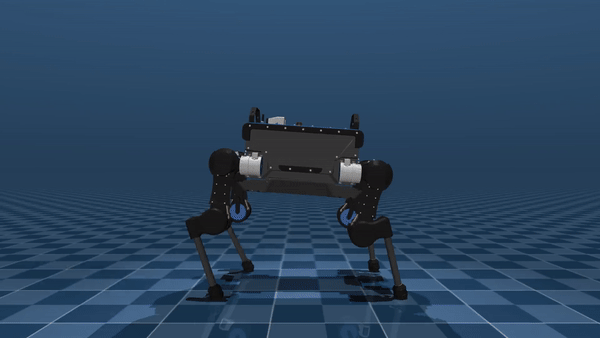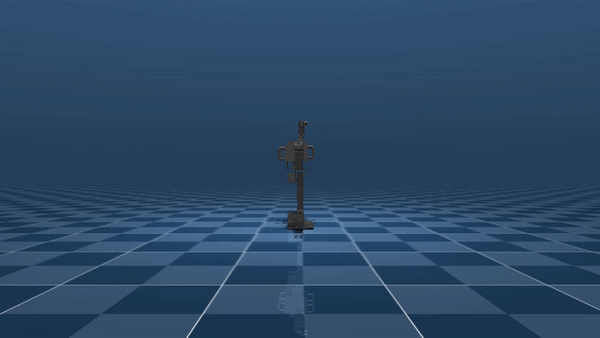Gymnasium/MuJoCo is a set of robotics based reinforcement learning environments using the mujoco physics engine with various different goals for the robot to learn: standup, run quickly, move an arm to a point.
Originally introduced as version 0 in gym==0.0.1 way back in 2016, this was shortly followed by version 1 (gym=0.1.0) to address several configuration errors.
In 2018, version 2 in gym=0.9.5 was released, which brought major backend improvements using mujoco-py=>1.5 simulator.
Version 3 (gym=0.12.0 in 2018) offered increased customization options, enabling users to modify parts of the environment such as the reward function and slight adjustments to the robot model.
With Google-DeepMind buying MuJoCo, open sourcing the code and releasing a dedicated python module (mujoco), version 4 ports the environments to the new mujoco>=2.2.0 simulator however removed the capability to slightly modify the environment.
The models in Gymnasium/MuJoCo were made around 2012 and they pre-date the “modern” robotics revolution and are not realistic relative to actual robot systems. All the version releases from the version 1 provide useful additional customization options, back-end improvements and bug fixes, but use the same unrealistic robot models.
Over time, the MuJoCo environments have become standard testing environments in RL, used in hundreds if not thousands of academic papers at this point. They have provided a standard set of difficult-to-solve robotic environments, and a cornerstone in the development and evaluation of RL methods.
However, as RL methods continue to improve, the necessity for more complex robotic environments to evaluate them has become evident with state-of-the-art training algorithms, such as TD3 and SAC, being able to solve even the more complex of the MuJoCo problems.
We are pleased to announce that with gymnasium==1.0.0 a new 5 version of the Gymnasium/MuJoCo environments with significantly increased customizability, bug fixes and overall faster step and reset speed.
pip install "gymnasium[mujoco]>=1.0.0"
import gymnasium as gym
env = gym.make("Humanoid-v5")
Add support for loading third-party MuJoCo models, including realistic robot models, like those found in MuJoCo Menagerie.
Ant, Humanoid and HumanoidStandup. This results in 5-7% faster training with SB3/PPO using pytorch (related GitHub issue).v3 → v4 transition.info that include all reward components and non-observable state, and reset() now returns info which includes non-observable state elements.friction==1.9, previously the right foot had friction==0.9 and the left foot had friction==1.9 (related GitHub issue).healthy_reward, was previously given on every step (even if the robot was unhealthy), now it is only given when the robot is healthy, resulting in faster learning. For further details about the performance impact of this change, see the related GitHub issuecontact_cost reward component was constantly 0. For more information on the performance impact of this change, please check the related GitHub issue #1, GitHub issue #2.info fields.
info["reward_ctrl"] sometimes containing contact_cost instead of ctrl_cost.info["x_position"], info["y_position"] and info["distance_from_origin"] giving xpos instead of qpos observations (xpos observations are behind 1 mj_step(), for more details see here) (related GitHub issue #1 & GitHub issue #2).info["reward_ctrl"] not being multiplied by the reward weight.For those looking for more complex real-world robot MuJoCo models, v5 now supports custom robot models for each environment. Below, we show how this can be achieved using models from the MuJoCo Menagerie project.
Depending on the robot type, we recommend using different environment models: for quadruped → Ant-v5, bipedal → Humanoid-v5 and swimmer / crawler robots → Swimmer-v5.
However, it will be necessary to modify certain arguments in order to specify the desired behavior. The most commonly changed arguments are:
xml_file: Path to the MuJoCo robot (MJCF or URDF file).frame_skip: The duration between steps, dt, recommended range is $[0.01, 0.1]$ where smaller values allow more precise movements but require more actions to reach a goal.ctrl_cost_weight: The weight of control cost in the reward function, set it according to the needs of the robot, we can set it to 0 at first for prototyping and increase it as needed.healthy_z_range: The upper and lower limit the robot can be at without it besing “unhealthy”, set it according to the height of the robot.
For more information on all the arguments, see the documentation pages of Humanoid, Ant and respectively.env = gymnasium.make('Ant-v5', xml_file='./mujoco_menagerie/anybotics_anymal_b/scene.xml', ctrl_cost_weight=0.001, healthy_z_range=(0.48, 0.68), render_mode='human')
Here all we have to do is change the xml_file argument, and set the healthy_z_range, because the robot has a different height than the default Ant robot. In general, we will have to change the healthy_z_range to fit the robot.

env = gymnasium.make('Ant-v5', xml_file='./mujoco_menagerie/unitree_go1/scene.xml', healthy_z_range=(0.195, 0.75), ctrl_cost_weight=0.05)

env = gymnasium.make('Humanoid-v5', xml_file='~/mujoco_menagerie/robotis_op3/scene.xml', healthy_z_range=(0.275, 0.5), include_cinert_in_observation=False, include_cvel_in_observation=False, include_qfrc_actuator_in_observation=False, include_cfrc_ext_in_observation=False, ctrl_cost_weight=0, contact_cost_weight=0)

For a more detailed tutorial, see loading quadruped models.
For more information about the development of the Gymnasium/MuJoCo-v5 environments and a complete changelog, check the GitHub PR.